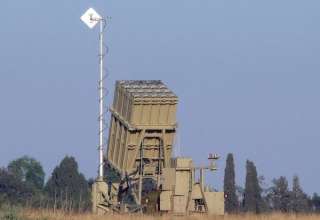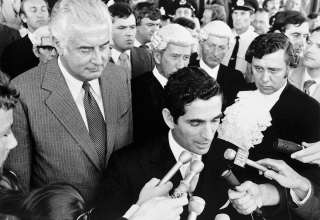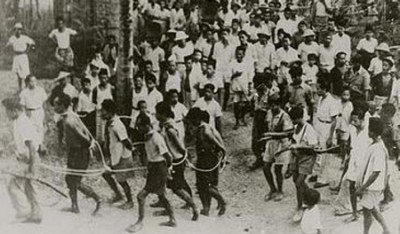 On October 1, 1965, Major-General Suharto made the decisive moves that allowed him 18 months later to displace President Sukarno and take supreme power in Indonesia.
On October 1, 1965, Major-General Suharto made the decisive moves that allowed him 18 months later to displace President Sukarno and take supreme power in Indonesia.
But the events of October 1 –the capturing and killing of senior Indonesian generals and the rapid and brutal response of the military, led by Suharto, which captured or killed the key conspirators have been clouded in mystery. Was the communist party the sole force behind the attack on the generals that triggered the military seizure of power? Did Suharto have forewarning? Did the CIA engineer the events? How involved were American and other foreigners in the organisation of the ruthless massacre of the supporters of the Left in Indonesia that followed the events of October 1?
Humphrey McQueen has reviewed the available evidence and here sets out to reconstruct the motives and actions of the key players of that day – Sukarno, Suharto, Aidit, the leader of the communist party, and US ambassador Marshall Green along with the US military training group. McQueen can find no single puppetmaster but he points to the enormous influence on Australia of those events of October 1.
How Suharto won power
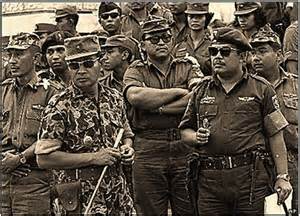 Round 4 am on Friday, October 1, 1965, a small group of soldiers arrived at the Jakarta homes of seven senior Indonesian generals. Within minutes, three of the generals were dead, including army chief Yani. Three others were abducted and one, defence minister Nasution, escaped. After being taken to nearby Halim air force base, the surviving captives were killed and all the bodies dumped into a well. Shortly after 7 am, Radio Jakarta quoted Lt-Colonel Untung, an officer of President Sukarno’s personal bodyguard, as declaring the action was “solely a movement within the Army”, made necessary to protect Sukarno from a CIA-sponsored “Council of Generals” that had planned “a show of force” for Armed Forces Day on October 5. Later in the day, Untung announced the composition of a 45-member Revolutionary Council, including 23 military or police officials, several women and four minor Communist Party of Indonesia (PKI) leaders. Few of those named had been consulted. Shortly before 9 pm on the day of the coup, supporters of Major-General Suharto who, after the disappearance of the other generals had assumed de facto command of the army, broadcast that “a counter-revolutionary movement” had been suppressed.
Round 4 am on Friday, October 1, 1965, a small group of soldiers arrived at the Jakarta homes of seven senior Indonesian generals. Within minutes, three of the generals were dead, including army chief Yani. Three others were abducted and one, defence minister Nasution, escaped. After being taken to nearby Halim air force base, the surviving captives were killed and all the bodies dumped into a well. Shortly after 7 am, Radio Jakarta quoted Lt-Colonel Untung, an officer of President Sukarno’s personal bodyguard, as declaring the action was “solely a movement within the Army”, made necessary to protect Sukarno from a CIA-sponsored “Council of Generals” that had planned “a show of force” for Armed Forces Day on October 5. Later in the day, Untung announced the composition of a 45-member Revolutionary Council, including 23 military or police officials, several women and four minor Communist Party of Indonesia (PKI) leaders. Few of those named had been consulted. Shortly before 9 pm on the day of the coup, supporters of Major-General Suharto who, after the disappearance of the other generals had assumed de facto command of the army, broadcast that “a counter-revolutionary movement” had been suppressed.
The events of October 1 have been widely referred to as “an attempted communist coup” that led to the replacement of Sukarno by General Suharto. Suharto’s New Order regime claimed that the PKI was solely responsible for the “incident”. Using a notion taken from Indonesian puppet theatre, all sides have sought to identify the “puppetmaster” (dalang), who manipulated Untung’s “movement” from behind a screen. Few foreign experts have accepted the official interpretation. Some left-wing academics argued that Suharto himself masterminded Untung’s action in order to justify his own reactionary plans. Many Western authorities accept that communist involvement was secondary, indeed marginal, though fewer would now say non-existent.
No reconstruction can be completely convincing while so much documentation is suspect or missing. Evidence for PKI guilt presented at the subsequent trials was either the uncorroborated confessions of dead men, was obtained under duress, or was the testimony of a double agent. The case against Suharto gains most in credibility by reading the story backwards on the principle that the beneficiary must have been the perpetrator. Accusations about CIA involvement are based on its known character rather than on specific information about its activities in Jakarta during September 1965.
The reporting of the manner of the generals’ death is a good example of how the truth has been slow to emerge from the shadow of propaganda. On October 4, Suharto sent television and film crews to the Halim air force base to record the grisly exhumation of the bodies. Shortly afterwards, the US ambassador to Indonesia, Marshall Green, cabled the State Department recommending covert measures to “spread the story of the PKI’s guilt, treachery and brutality”. On October 6, Indonesian newspapers claimed that the six generals had been tortured. They published stories of communist women confessing to castrating the victims and gouging their eyes out. By the end of November, Indonesia’s official news agency had reported the women danced naked before PKI chairman Aidit and copulated indiscriminately with a PKI youth group. Such stories had an undoubted impact on those Indonesians for whom desecration of the dead and sexual display were especially abhorrent. The Australian newspaper told of Untung participating in a “blood dance of death”. Were such reports concocted, as well as spread, by US agencies? Although their tone is typical of CIA “black propaganda”, it would be foolish to assume Indonesians incapable of making up their own lies. In fact, the mutilating tortures were invention. The official autopsy reports translated in 1987 by a Cornell University scholar, Ben Anderson, record no such mutilations.
Because the final outcome was so momentous, almost no writer has been prepared to accept that such consequences might have been unplanned. While all involved had long-term objectives, none could have supposed that the events of the morning of October 1 would lead directly to those aims. To explain what happened, everybody’s decisions on that day need to be viewed as affecting events that were still in the future, and hence open to several possible outcomes. The smashing of the Left and removal of Sukarno were not a single event but rather a set of overlapping results stemming from relatively distinct causes. Deciding who planned the generals’ abduction will not in itself explain what happened from October 1 because, by mid-1965, Indonesian politics and economics had moved beyond the control of any individual or grouping. The impossibility of a preconceived plan being able to steer the hurricane became even more evident as the entire social system exploded into mass slaughter during what was left of that year of dangerous living. Rather than seek a single controlling person or group, this reassessment emphasises the conflicting efforts of various actors to benefit from the chaos of Indonesian society.
Sukarno
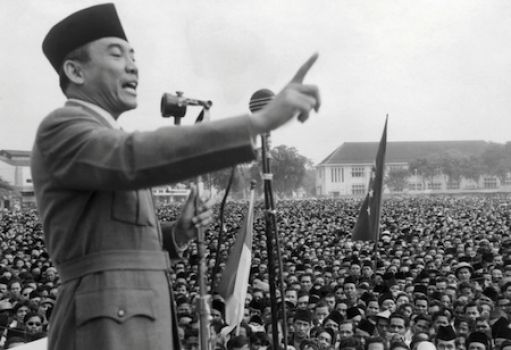 Looking back we can now see that the abduction was a step into the abyss: conceived in the preceding weeks, the incident could appear as nothing out of the ordinary in these extraordinary times. A US scholar, Roger Paget, paraphrased the research notes he took from informants during those hours:
Looking back we can now see that the abduction was a step into the abyss: conceived in the preceding weeks, the incident could appear as nothing out of the ordinary in these extraordinary times. A US scholar, Roger Paget, paraphrased the research notes he took from informants during those hours:
“There was no coup or attempted coup. There was a publicly acceptable step, consistent with the political trend of the preceding months, to protect the state from further reactionary influence of the corrupt capitalist-bureaucrat generals suspected of consorting with the allegedly omnipresent American CIA in a plot . . .”
We cannot know how the rest of the army would have reacted had the seven generals been handed alive, if not well, to Untung’s Revolutionary Council for a public trial, or to Sukarno for a tongue-lashing session of negotiations. Could the President have replaced them with more malleable officers? Would they have given in to pressures to train and arm left-wing unionists and peasants?
Economics was never President Sukarno’s strong point. His genius was for charismatic politics. The directed economy he promoted after 1957 was far from being centrally planned along Soviet lines. The military ran the most advanced sectors – those industries expropriated from the Dutch, Belgians and British – as fiefdoms under the martial law which existed almost without a break from 1957. (Suharto’s area of command involved sufficient profitable dealings by 1965 to maintain its own Import-Export Bank; here in embryo was the commercial military complex which has swelled under his presidency.) One immediate consequence of martial law was that the technocrats whom Sukarno had appointed to manage the economy were never allowed to direct its most crucial components. After 1963, fiscal problems were compounded by Sukarno’s personality and politics. His unwillingness to take decisions, and his need to incorporate as many groups as possible under his patronage, resulted in a cabinet with nearly a hundred ministers, all with distinctive uniforms but many without defined responsibility.
Overseas earnings went to purchase weapons or erect monuments as did aid from the Soviet bloc and the People’s Republic of China. Regional military commands were accustomed to sustaining their forces through a corrupting system of informal taxation. US oil and resource companies directed royalty payments to army commanders, thereby establishing conduits for political influence. By 1965, the Indonesian economy was in crisis. Forward estimates revealed exports dropping to $US450 million while essential imports and debt servicing would require $US 1,090 million, a shortfall of $US640 million. Between 1963 and 1965, the cost of rice rose from 200 to 1,500 rupiahs a kilo. During November and December 1965, prices of basic commodities soared, with petrol rising from 4 to 1,000 rupiahs per litre.
If economic stalemate weakened Sukarno’s position, the assumptions behind his international policies found fewer domestic critics. No matter how Islamic or anti-communist, the Indonesian military retained a heritage of revolutionary anti-colonialism. Had General Nasution replaced Sukarno as president in the 1950s, the campaign to incorporate West Papua within the republic would have gone ahead more or less as it did. On the other hand, Sukarno’s international forays deprived him of a wide range of overseas friends. He outraged US secretary of state John Foster Dulles by sponsoring the first meeting of Afro-Asian nations at Bandung in 1955 as a counter to the South-East Asia Treaty Organisation which the US strategists had cobbled together in Manila in September 1954. The Bandung Conference further angered Dulles by giving “Red China” an international forum in which Chou En-lai could work his charm and thus partly circumvent the US policy of excluding China from the United Nations. Refused substantial military aid by the US in 1960, Indonesia got further Soviet credits to purchase ships and aircraft. After the Kennedy administration engineered a peaceable transfer of West Papua from the Netherlands to Indonesia via the United Nations in 1963, Sukarno moved closer than ever to Mao’s China. Provoked by Britain’s bellicose Commonwealth secretary, Sukarno “confronted” the new Greater Malaysia as neo-colonialist. Although the right-wing generals were unhappy about Britain’s combining of Malaya, Singapore and parts of Borneo into one nation, they were far more worried about the domestic consequences of Confrontation with Malaysia because the PKI’s enthusiasm for the campaign strengthened its standing with Sukarno. Worst of all, the British, abetted by the Menzies government, were determined to fight. The US feared that an almost inevitable British victory would weaken the capacity of the Indonesian army to combat the PKI. Suharto subverted his role as deputy- commander of the “Crush Malaysia” campaign by maintaining secret negotiations with Malaysian leaders to ensure that Confrontation would remain primarily a rhetorical contest, leaving the senior generals free to concentrate on the greater danger to both Malaysia and themselves, namely, the political Left.
By September 1965, Sukarno’s foreign policies had cut him off from the US alliance powers, offended India and the Soviet bloc by defending China and, most seriously, produced a new split between him and senior generals who were dragging the chain over Confrontation.
Nevertheless it was Sukarno who kept this cauldron from boiling over. President of Indonesia since its declaration of Independence in 1945, his name and voice possessed a magical power for many Indonesians who honoured him as their Sultan, maintaining a traditional court. He kept the diverse political, religious and ethnic groups from tearing the republic apart as had happened in Korea, China, Malaya, Vietnam and India. If Sukarno were to die, no-one could take his place and the contending forces would fight it out.
Under martial law, parliamentary politics and elections had come to a halt and the main players sought new ways to advance their interests.
Fearful of the continued growth of the PKI and its leftist allies in the Nationalist Party (PNI), the army opposed the holding of elections. Sukarno at first hoped to see the parties replaced by organisations representative of functional and cultural allegiances. As a result, the PKI built up its front organisations and the army worked through a number of bodies such as Sekber GOLKAR. To defuse that form of competition, Sukarno proposed combining nationalism, Islam and communism into a political ideal, acronymed as NASAKOM.
By mid-1965, the PKI and the PNI had earned the president’s patronage by supplying him with mass audiences. This success has been used to argue the PKI’s guilt and its innocence: defenders say that the PKI had no reason to derail a dynamic driving in their favour; its accusers claim that the party’s leadership moved out of fear either that Sukarno would soon die or that a “Council of Generals” was about to shove the system back towards the centre.
Aidit and the PKI
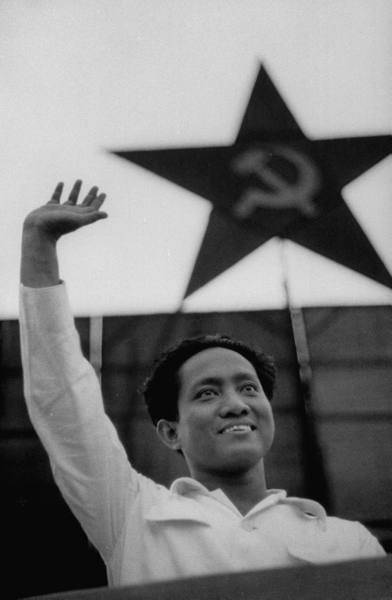 In their propaganda and during the trials, Suharto’s supporters placed the entire responsibility for initiating and directing Lt-Col Untung’s “movement” on to the PKI, even to the point of claiming its chairman, Aidit, wrote the colonel’s radio broadcasts. The official position remains that the PKI was the sole puppetmaster. Disputable as every other explanation remains, that strict Jakarta line is not taken seriously either by outside commentators or by many informed Indonesians in private. The issue is: in what way was the PKI implicated?
In their propaganda and during the trials, Suharto’s supporters placed the entire responsibility for initiating and directing Lt-Col Untung’s “movement” on to the PKI, even to the point of claiming its chairman, Aidit, wrote the colonel’s radio broadcasts. The official position remains that the PKI was the sole puppetmaster. Disputable as every other explanation remains, that strict Jakarta line is not taken seriously either by outside commentators or by many informed Indonesians in private. The issue is: in what way was the PKI implicated?
Scholars concerned to acquit the PKI have had little difficulty in discrediting some of the primary evidence presented at the trials since it came from a tainted witness, Sjam, who was said to be a senior PKI agent. After eluding the authorities for two years, Sjam provided their case with the missing link. According to Sjam, Aidit placed him in charge of a “secret bureau” to contact sympathisers within the armed forces. Sjam testified that in August 1965 Aidit had told him to activate elements within the military to remove the anti-PKI generals before either they, or death, removed Sukarno. Thus the official story is that Aidit instructed Sjam, who manipulated Untung, who murdered the Council of Generals. This causal chain would be more convincing if a CIA analysis of the Untung “movement” published in the 1960s had not identified Sjam as a double agent and an informer for the Jakarta military command, and whose allegiance in the 1950s had been to the ClA-funded Socialist Party (PSI). Since Aidit and most of his inner party circle were killed without trials, the only survivor in a position to report that the “secret bureau” ever existed was Sjam. Sjam proved so cooperative that he was allowed periods out of jail, was asked to write political reports and was not executed despite his admitting to having been the lynchpin in the “attempted communist coup”. Nonetheless, conclusive evidence that Sjam had been an agent provocateur would not establish PKI innocence.
Aidit did not need Chairman Mao to remind him that political power grew out of the barrel of a gun. The PKI advanced two proposals to deprive the military of its monopoly of weapons. One, the army should be opened up to communist ideology; two, a “fifth force” or people’s militia should be trained and armed. The second idea, promoted by Chou En-lai, gained Sukarno’s endorsement.
If details of Sjam’s evidence concerning the “secret bureau” within the PKI are suspect, there is no reason to believe that Aidit was so naive as not to build bridges to sympathetic officers. What remains uncertain is who ended up manipulating whom. Piecing together evidence gathered by other writers about possible puppetmasters, I favour an explanation along the following tangle of lines: in order to calm Aidit’s fears about the Council of Generals and its “contingency plans”, President Sukarno let his bodyguard Untung understand that he should “take measures” against army chief Yani and defence minister Nasution; Aidit, as his politburo critics later accepted, independently activated Sjam to identify army officers friendly to Sukarno; Sjam’s right-wing controllers pressed that “double-agent” to embroil the PKI leaders with Untung’s movement against the seven generals. Such a scenario accords with the swirling cross-currents that swept political affairs during 1965, and conforms to the picture of Aidit confident – perhaps giddy with success – that the PKI could hitch a further ride from pro-Sukarno forces. For months, the communists had been boasting that they were “already victorious, not yet in office”. As a minister without portfolio, Aidit appeared beside Sukarno at rallies in the special uniform of a cabinet member, so that the PKI appeared to be the “party of the state”.
As the trial evidence indicated, Aidit remained at the Halim air force base throughout October 1 but did not confer with Sukarno, who had been brought there at 9 am, or with the rebel officers, suggesting that the PKI role in Untung’s “movement” was peripheral. An air force plane took Aidit into hiding in central Java, where he was shot shortly after capture on November 22. During the afternoon of October 1 the Jakarta communist daily newspaper published its Saturday edition, expressing circumspect support for any pro-Sukarno action against the “ClA-backed Council of Generals”, as did the PNI media. The number of PKI demonstrations throughout the republic favouring Untung’s “movement” was hardly more than on any other day on behalf of progressive causes. The PKI leadership agreed to fall in behind Sukarno’s hope of continuing as if nothing unusual had occurred. The “surprise” over the killings of the six generals precipitated a bout of Sukarno’s indecisiveness in effect, he abdicated one source of his authority by allowing General Nasution to inflame the funeral crowds on October 6 and 7, while he stayed away, uncharacteristically silent, giving his first press conference a week later. PKI cadres advised their organisations to be on the alert but made no attempt to mobilise millions of members and supporters. Some party members took to the streets and used violence against their opponents but again these attacks were no more frequent than had become normal since the start of 1964. This low level of response justified US academic Donald Hindley’s view of the PKI as a paper tiger, numerically huge but a prisoner of Sukarno’s popularity and materially and psychologically unprepared for armed struggle. The behaviour of the PKI after October 1 is consistent with one faction in its top leadership going along with a plan to reduce the power of Yani and Nasution without qualitatively altering the social system. There is no warrant for the cliché about “an attempted communist coup”.
Untung and the generals
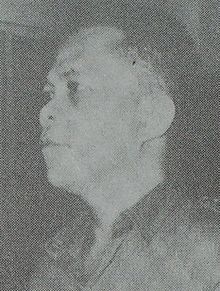 Untung announced his action as “solely a movement within the army”, which was truer of its origins than its development by October 1, when its key allies came from the air force. Suharto’s New Order regime has always been anxious to deny divisions within the army yet a convincing history of Indonesian politics since independence can be constructed with intra-army disputes as its central dynamic. The so-called “communist uprising” around Madiun in Central Java in 1948 began as a struggle between guerrilla leaders and central commanders trained by the Dutch or Japanese; the PKI leadership attached itself to the radical and losing side, providing the first occasion for General Nasution to launch a mass killing of communists and to create the legend of a treacherous PKI. Four years later, the PKI began its rehabilitation by backing the political winners during a parliamentary crisis intensified by the chief-of-staff’s desire to pension off guerrilla officers. Nasution defeated preparations for an intra-military coup in 1956. His suppression of the 1957- 58 right-wing military rebellions in Sumatra and Sulawesi was another instance of central versus regional tussles within the army. The army’s accommodation with Sukarno continued primarily from their assessment that only his authority could hold the republic together.
Untung announced his action as “solely a movement within the army”, which was truer of its origins than its development by October 1, when its key allies came from the air force. Suharto’s New Order regime has always been anxious to deny divisions within the army yet a convincing history of Indonesian politics since independence can be constructed with intra-army disputes as its central dynamic. The so-called “communist uprising” around Madiun in Central Java in 1948 began as a struggle between guerrilla leaders and central commanders trained by the Dutch or Japanese; the PKI leadership attached itself to the radical and losing side, providing the first occasion for General Nasution to launch a mass killing of communists and to create the legend of a treacherous PKI. Four years later, the PKI began its rehabilitation by backing the political winners during a parliamentary crisis intensified by the chief-of-staff’s desire to pension off guerrilla officers. Nasution defeated preparations for an intra-military coup in 1956. His suppression of the 1957- 58 right-wing military rebellions in Sumatra and Sulawesi was another instance of central versus regional tussles within the army. The army’s accommodation with Sukarno continued primarily from their assessment that only his authority could hold the republic together.
Although the post-1952 resurgence of the PKI presented the army leadership with a common enemy, their internal divisions never disappeared. Nasution remained an outsider among the top brass because he was an honest, Islamic Sumatran who had fallen among corrupt, syncretist Javanese. In addition, dissatisfaction affected junior officers offended by the gap between the way many generals lived it up in Jakarta and the harsh conditions endured by combat troops. In March 1965, several hundred junior naval officers at Surabaya went on strike against their commander’s links to the army leadership without any PKI inspiration, according to Queensland University academic Ulf Sundhaussen. As a hero of the campaign to remove the Dutch from West Papua, Untung suffered from the neglect of corrupt commanders and his initial statement denounced officers “who above the accumulated sufferings of their men have lived in luxury, led a gay life, insulted our women and wasted government funds”. Untung’s movement took root within the army’s grievances, and did not need to be planted by either clandestine PKI agents or rightwing provocateurs. The dissident officers did not remain “solely a movement within the army” but came to an understanding with Aidit to reduce the political restrictions and the corruptions fostered under martial law. Untung’s October 1 announcement that all his superiors were to be demoted to the rank of colonel was in keeping with the flow of politics throughout 1965.
Scholars like Sundhaussen accept that Aidit ran a “special bureau” to influence army leftists, but reject the view that Yani headed a Council of Generals to deal with the PKI. Questioned by Sukarno, General Yani had acknowledged that a group of generals met regularly to decide senior appointments and promotions. Such procedural matters were acutely political because Yani needed to deploy left-leaning commanders where they could do the least harm.
As Bryan Evans III has shown in a recent issue of the Cornell University journal Indonesia, US service training programs encouraged the army to build backing in the villages. With backing from several US universities, Yani presided over a military politburo that prepared contingency plans for blocking further PKI advances. Yani, no less than Aidit, needed to be prepared for Sukarno’s sudden death or incapacitation. In particular, he had to cope with presidential demands to rid the army of its “communistophobia” and with PKI pressures to create a “fifth force”. While the PKI sought allies to continue shifting the nation towards the left, the army chiefs attempted to reduce PKI influence. In September 1964, Yani had founded a mass organisation to oppose the PKI in the name of “Upholding Sukarnoism”, a body which the president dissolved in December. On my reading, in the febrile politics of August-September 1965, Yani’s Council of Generals was preparing to protect its residual power by checking the PKI. Such a blocking manoeuvre does not mean that Yani intended a coup against Sukarno, despite Untung’s accusation. Just as Aidit favoured Untung’s movement as one more step forward, so the Council of Generals would have seen its immediate steps as little more than a retarding tactic. Untung’s failure to produce evidence of the generals’ preparations tells us only who ended up controlling the state machinery.
Marshall Green and the CIA
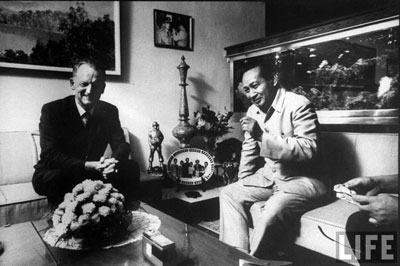 Untung’s initial broadcast linked the Council of Generals to the CIA, a claim more readily dismissed before the extent of covert US activities was revealed. Today, researchers confront the opposite problem. Overwhelmed by evidence from a series of exposures and congressional hearings, it is too easy to assume that the CIA must have been the prime mover in Jakarta. The available evidence is that the CIA tried a number of unsuccessful operations in Indonesia during the 1950s; that its own assets there by September 1965 were few and marginalised; but that it sprang into the field immediately after Suharto defied the president and moved against Untung. To say that the CIA got the result it desired and that it backed Suharto does not make the CIA into anybody’s puppetmaster. More important, concentration on the CIA allows other networks for carrying US influence into the Indonesian army to pass unexamined.
Untung’s initial broadcast linked the Council of Generals to the CIA, a claim more readily dismissed before the extent of covert US activities was revealed. Today, researchers confront the opposite problem. Overwhelmed by evidence from a series of exposures and congressional hearings, it is too easy to assume that the CIA must have been the prime mover in Jakarta. The available evidence is that the CIA tried a number of unsuccessful operations in Indonesia during the 1950s; that its own assets there by September 1965 were few and marginalised; but that it sprang into the field immediately after Suharto defied the president and moved against Untung. To say that the CIA got the result it desired and that it backed Suharto does not make the CIA into anybody’s puppetmaster. More important, concentration on the CIA allows other networks for carrying US influence into the Indonesian army to pass unexamined.
During the 1950s, the CIA suspected all nationalist leaders of being crypto-communists and favoured reactionaries such as South Korea’s Syngman Rhee, or modernising autocrats like the Shah of Iran. From 1953, the CIA tried to set up a chain of bookstores in Indonesia as cover for “status and action”; only one store opened, no real work was done, and the concern lost $100,000 and the CIA man in charge attempted suicide. From 1953, the CIA also started to give millions of dollars to the anti-communist Indonesian Socialist Party (PSI) and its unions. To counter PKI and Sukarnoist forces, the CIA provided a progressive Islamic party, Masjumi, with $US1 million for its 1955 election campaign – at which the Masjumi lost votes to the traditionalists of the Nadatul Ulama (NU). In the autumn of 1956, the CIA deputy-director of plans told his underlings to find a way of holding “Sukarno’s feet to the fire”. With few assets in Indonesia and none close to anyone still in power, the CIA waited for something to turn up, which it did when a group of colonels in Sumatra started their own anti-Jakarta movement and then got in touch with the CIA. After Soviet President Voroshilov visited Sukarno in 1957, the CIA, in order to gain support elsewhere in Washington for a major operation to reduce Sukarno’s power, created evidence that Indonesia was moving from neutrality to satellite status. Aware that Sukarno was sexually involved with a Russian airline stewardess the CIA concocted films from old porn movies purporting to show Sukarno, represented by a bald Mexican, having sex with a KGB blonde. The clips failed to convince. Urged on by the Dulles brothers – John Foster at the State Department and Allen as CIA chief – the CIA gave armed support to the rebel officers in Sumatra. Forces under the command of the anticommunist Islamic Sumatran General Nasution suppressed that revolt, showing how Indonesian military politics contained dynamics distinct from Washington’s cold-war priorities. CIA involvement came to a murderous end when the Indonesians captured one of its undercover pilots after he bombed a church on Ambon in May 1958. The CIA also identified an “asset” for an assassination attempt on Sukarno. After an unknown attacker tried to kill the president on November 30, 1957, the CIA used its press assets in Indonesia to claim that the PKI had arranged the assault in order to paint Sukarno’s enemies as “wild and desperate men”.
The CIA continued to have difficulty in acquiring assets inside Indonesia but shared information with cooperative oil and construction companies. Aircraft sales became the conduit for transferring funds. Former Canadian diplomat Dale Scott documented how, before 1965, Lockheed and Rockwell-Standard, as well as Stanvac, paid off three Suharto cronies who have gone on to greater depths: General Alamsjah, still a cabinet minister; Bob Hasan, the timber czar; and General Sutowo, the disgraced boss of the national oil conglomerate who remains one of Indonesia’s leading entrepreneurs.
The CIA did not create or direct Untung’s movement, nor did Suharto need to have his reactions during October 1, 1965, guided by foreigners. Presented with that rupture, all the US agencies, in the words of ex-CIA operative Ralph McGehee, “seized upon this opportunity”. CIA and State Department officials have boasted that they supplied anti-PKI forces with details of 5,000 communist leaders to be eliminated; one political officer in the embassy confessed that “I probably had a lot of blood on my hands, but that’s not all bad. There’s a time when you have to strike hard at decisive moment.”
Australian leftists have played up the arrival of Marshall Green as US ambassador accusing him of being a coup master-general in Seoul, Jakarta and Canberra. Green’s appointment to Jakarta helped Suharto to power but not in the sense of setting up coups. Green’s predecessor, Howard Jones, had arrived during 1958 when the State Department was still backing CIA schemes to oppose Sukarno by force. Jones soon perceived that Sukarno was the only one in Indonesia who could contain the reviving power of the PKI and that the US should accept his demand for the incorporation of West Papua. Ignored and abused by the Dulles brothers, Jones hung on until his views became the State Department policy late in 1961 after Kennedy became president. Three years later, the Jones strategy had not worked. Sukarno had been appeased but kept moving ever closer to the Chinese internationally, and to the PKI domestically. The US agencies were pressing the generals to move against the PKI. By 1965, Jones’s usefulness was over. A younger, tougher professional was essential. Although accredited as ambassador, Marshall Green brought the authority of a presidential special envoy. William Bundy recalled: We never moved a muscle without his advice.”
Green accepted that as head of mission he had at his disposal the resources of the military training group, the CIA and US corporations. The concept of a “country team” was introduced under Jones but Green reorganised this daily meeting between himself, the CIA station chief and other top officials into an executive council, as Harold Brands has shown from the partly declassified CIA documents in the LBJ Library.
Green arrived in mid-1965 to head a tiny and embattled staff. Establishing contact and building rapport with senior generals was risky for both sides and the US was anxious not to compromise its friends by open support or contact. Green also had to cope with Sukarno’s disapproval of Jones’s recall. In circumstances of public hostility to the US, Green could initiate little until opportunities presented themselves after October 1.
Green immediately grasped the chance to support Nasution and Suharto as the means of destroying the PKI. Jones, the previous ambassador, had been recruited before the 1940s when the US government began to wage perpetual war on behalf of eternal peace. He would have been more squeamish about associating with assassination squads. Green appreciated how licensed murder had been made an integral part of the Kennedy program for turning the tide against the Left in underdeveloped nations.
Credit for bringing US influences to New Order Indonesia belongs to several US agencies, with the police and military training groups proving to be more effective than the CIA, whose Langley headquarters held so little information that it had difficulty compiling a biographical sketch of Suharto on October 2.
The US Office of Public Safety (OPS) began training Indonesian police in 1954. Ten years later, Indonesia was getting 20 per cent of OPS funds, with 500 officers being trained outside the country during 1963. By then, almost every senior police official had passed through the hands of the US agency, notably all senior commanders in the paramilitary section. According to CIA officer Joseph B. Smith, those recruited as “assets” were inducted at a Baltimore brothel before returning to Indonesia to work for Americans who were there under cover of the US Economic Cooperation Administration.
A parallel program for military personnel brought Indonesian officers to US service schools. That scheme expanded after 1962 when a Military Training Advisory Group (MILTAG) moved to Jakarta. The number of officers trained in the US grew from 395 in 1957 to 4,000 by 1965 – half the officer corps and a third of the general staff. Suharto did not go to the US but came under American influence at Jakarta’s US-orientated School of Civic Action. From 1964 onwards, US operatives encouraged their contacts in the Indonesian army to move against the PKI and, during 1965, l5 civilian experts arrived to assist the MILTAG “civic action” program, a euphemism for counter-insurgency. On October 6, the State Department noted that the payoff had been to establish “clearly in the minds of Army leaders that the US stands behind them if they should need help”. In those volatile first days, US planners in Jakarta and around Washington feared that the army might not press home its opportunity to destroy the PKI, yet they also worried that obvious US encouragement to whomever was calling the shots in the army could rebound by giving evidence for Untung’s claim about a ClA-backed Council of Generals. Brands reports that Suharto’s men advised Green to lie low until asked for help, which they began demanding during November. Also using declassified materials, Gabriel Kolko has shown how – under the label of medical supplies – guns and communications equipment were despatched via the Bangkok embassy to ensure that the massacres could proceed more expeditiously.
A web of additional US programs, as outlined by US investigator David Ransom, helped ensure that the PKI could be destroyed and Sukarno displaced. In 1954, the Ford Foundation began its ClA-sponsored support for research and training on Indonesia at Cornell University and the Massachusetts Institute of Technology. Ford also funded a program at the University of Southern California’s Berkeley campus to produce US-style economists within the University of Jakarta, nesting around economics dean Sumitro, who had to go into exile after supporting the 1958 ClA-backed rebellion in Sumatra, but who returned after 1966 to become Suharto’s minister of trade and commerce. The Berkeley economists also taught at SESKOAD (Army Staff and Command School) at Bandung. Guided by the US defence attaché, SESKOAD produced a civilian brains-trust for Yani’s “contingency planning” to contain any PKI advance during a post-Sukarno transition. After Suharto seized control, the Jakarta university economists still needed “a lot of help from the US embassy” to write an investment law that satisfied the US corporations.
In May 1963, SESKOAD graduates organised anti-Chinese riots in Bandung to disrupt relations with Beijing. The Harvard-educated minister for higher education and research used older students who had returned from US universities to organise KAMI (Indonesian Student Action Council), which spearheaded the demonstrations against the PKI and Sukarno’s NASAKOM cabinet. Not until this phase could Ambassador Green add his South Korean experience to the manipulation of student demonstrations. KAMI never had more than a few thousand members, almost all of whom had been active in the PSI or religiously affiliated student organisations.
These professional students were tied to village leaders and Moslem youth who joined in the massacre of leftists. Proclaiming themselves “The 1966 Generation”, KAMI and its similarly organised private-school equivalent, KAPPI, were used to keep up pressure for Sukarno to be stripped of all power.
Suharto
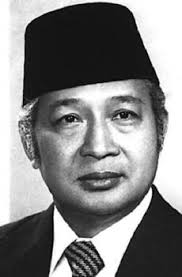 In absolving the PKI from responsibility for Untung’s movement, left-wing scholars such as W. F. Wertheim offered an alternative puppetmaster – President Suharto himself. One problem with this account is the impossibility of anyone’s foreseeing in September 1965, still less directing, the chaos through which Suharto achieved presidential power. To accept that Suharto surprised himself by becoming acting-president is not to rule out his developing more limited aims once he became aware of Untung’s plans. Cromwell’s dictum applies: “A man never rises so high as when he does not know where he is going.”
In absolving the PKI from responsibility for Untung’s movement, left-wing scholars such as W. F. Wertheim offered an alternative puppetmaster – President Suharto himself. One problem with this account is the impossibility of anyone’s foreseeing in September 1965, still less directing, the chaos through which Suharto achieved presidential power. To accept that Suharto surprised himself by becoming acting-president is not to rule out his developing more limited aims once he became aware of Untung’s plans. Cromwell’s dictum applies: “A man never rises so high as when he does not know where he is going.”
Although the case against Suharto is circumstantial, an independent prosecutor would have sought answers to several questions. Why was Suharto not on the list of generals to be abducted? His claim that he was not important enough is false, since he had routinely acted as chief of the army during Yani’s absences, had formed KOSTRAD (Strategic Command) in 1963, and in January 1965 had been appointed deputy-commander of the forces supposedly confronting Malaysia. Secondly, in occupying Merdeka Square, why did Untung place troops in front of the presidential palace, the radio station and the communications building, but not on the fourth side, where Suharto’s KOSTRAD had its headquarters and from which the rebel battalions were disarmed or dispersed? Thirdly, why did one of the principal plotters, Colonel Latief, call on his old friend Suharto late on the evening of September 30? The persuasiveness of the explanations that Suharto has offered for this encounter has not been increased by their multiplying contradictions. Yet the circumstantial evidence against Suharto can also be interpreted in his defence. Latief had been Suharto’s comrade-in-arms since the 1940s; in April 1964, Suharto had attended Untung’s wedding. These personal relationships might have protected Suharto and subsequently preserved Latief’s life. Suharto’s accusers allege that, through his old friend Sjam, he set up Untung to eliminate his rivals in the army high command and then blamed the PKI, a scenario as believable as one portraying Aidit as Untung’s sole manipulator.
If Latief gave Suharto advance notice that a movement within the army would “take measures” on October 1, Suharto might have seen such an action as personally advantageous. Although powerful, Suharto was no friend of Nasution, who had punished him in 1959 for corruption. Suharto had been on the outer with Yani’s group since winning the battle to establish KOSTRAD. A movement that aimed at the ousting of these chiefs was not necessarily a threat to Suharto. Following this line, Suharto would have had no reason to defy Sukarno openly until after learning, as he did during the afternoon of October 1, that the president had nominated a rival to take over as army chief. The questions posed above have yet to be answered in a way that clears Suharto of all complicity in Untung’s preparations. Thousands of his opponents were executed on far less evidence.
Suharto’s path to the presidency demanded tact and determination, since he had to ward off Nasution and civilian claimants as well as topple Sukarno who, well into 1968, retained too much popularity and elite loyalty to be treated lightly. Any explanation that collapses all these unpredictable steps into a well-oiled escalator, driven by some single power towards a final result, owes more to theology than political activity. After early October 1965, Suharto’s move towards state power benefited from his monopolising control over the power of the gun.
Chronology
1945 Indonesians declare Independence from three centuries of Dutch rule.
Sukarno becomes president.
1949 Dutch withdraw from all of East Indies except West Papua.
1950 Federal system replaced by unitary government.
1957-58 CIA supports rebellions in outer islands against Sukarno.
1957-58 Replacement of parliamentary elections by Guided Democracy; imposition of martial law.
196 2-63 Transfer of West Papua from the Dutch to Indonesia.
1963 British set up Federation of Malaysia;
Sukarno begins Confrontation against such neo-colonialism.
1964 Communist Party (PKI) holds insignificant positions in Sukamo’s cabinet of almost 100 members but promotes land reform in villages.
1965:
August Concern about Sukarno’s health.
September Inflation increases rapidly.
October 1
4 am Abduction of generals by an armed forces movement headed by Colonel Untung.
7 pm Major-General Suharto takes command of army and suppresses Untung’s movement.
October 22 Massacre of leftists begins.
November 22 – 23 Aidit, Communist Party chairman, captured and killed.
March 1966 PKI outlawed.
March 1967 Suharto elected acting-president.
1968 Sukarno finally loses title of president.
1970 Sukarno dies.
Massacres
How many tourists to Bali realise that late in 1965 that island became a slaughterhouse rivalling Pol Pot’s Kampuchea? Do outsiders know more about the murder of the six generals than the murder of hundreds of thousands of Indonesians? Estimates of the death toll have ranged from 78,000 to a million, with 500,000 accepted by many commentators.
Today, the killings are frequently presented as happening in “the aftermath of the failed communist coup”: a more accurate terminology would be to describe the slaughter as “a one-sided civil war”. Much of the misunderstanding about what happened in Indonesia during 1965 and 1966 stems from focusing on the elite politics of Jakarta. By redirecting attention to Indonesia’s villages it becomes appropriate to talk about “attempted communist coups” in the plural. Such “coups” were not intended to take over the nation-state but to transform social and economic relationships within thousands of communities.
On Bali, as Adrian Vickers has shown, the PKI’s “unilateral action” to enforce laws promising land and harvest redistribution challenged the entire Hindu caste system. In Islamic areas of the archipelago, a militant peasantry sympathetic to the PKI threatened the status of religious teachers who were among the country’s few large landholders.
In September 1965, the PKI had three million members; some 20 million Indonesians belonged to popular-front organisations, including nine million in the Peasants Front (BNI). While US agencies made sure that 5,000 senior PKI officials were eliminated, the majority of those murdered were far from being hardened party cadres. In the bloodletting, people who had not gone to work on September 30 and October 1 became suspect. Chinese were attacked because they were foreign and successful. Personal grudges were settled under the mantle of anti-communism. The mass of victims included illiterate nominal Catholics who had seen the PKI as a new cargo cult and for whom dialectical materialism was a more puissant magic. In rounding up people to kill, the army and its supporters used the same kind of definition of “communist” as was popular in 1965 in Australia, namely, anyone to the Left. Consequently, left-wingers in the nationalistic, Muslim and Christian parties were decimated.
Slaying of PKI supporters began in Banda Aceh in northern Sumatra on October 1 in reaction to news that Muslims had been killed in Jogjakarta; this spontaneous outbreak highlights that strongly Islamic areas with long histories of secessionist revolt had reasons of their own to turn on leftists. Yet, as with pogroms in Europe, most local participation in the slaughter had to be activated by state-backed organisations, whether the army itself or ministerially-directed student and youth groups. Large-scale killings on Java did not begin until mid-October when they were initiated by forces sent into central Java. On finding that they had too few troops, “Red Berets” operating in the Solo area trained local youths and, in the words of the unit commander, sent them out “to kill communists”. Elsewhere officers handed village chiefs lists of those to be killed. Failure to follow orders became proof of communist sympathies. One Catholic headman who refused to murder anyone agreed to bury the dead. Very soon, there were too many corpses to bury. So many bodies were thrown into streams that they formed log-jams, turned the waters red and polluted the drinking supply. Orphaned children crowded railway stations begging for food. Foreign journalists provided some contemporary accounts but those massacres frequently are still unmentionable within the communities where the killings took place, although anthropologists such as Paul Webb have gathered details from the islands of Bali, Flores, Sumba and Timor.
The Suharto regime brought some system to the treatment of those opponents who had survived the massacre, by dividing political prisoners into three categories: A, those who could be tried for implication in Untung’s movement; B, activists in the leftist parties or their support organisations, like the novelist Pramoedya, who were sent to the Gulag on Buru island; C, a random collection, including a teenage student picked up at a pro-Sukarno demonstration and a l2-year old boy taking food to his B-category father. By March 12, 1966, when Suharto banned the PKI in Sukarno’s name, the party and its supporting organisations had all but ceased to operate.
Within Indonesia, the consequences of the Suharto takeover have been 25 years of rule by a commercial-military complex; struggles between rural classes have been displaced by conflicts between urban bureaucrats, each side linked to competing Japanese and US investors, such as the 1990 tussle between the telecommunications giants, NEC and AT&T. Having unleashed religious zealots to murder the Left, the Javanese elites now fear a “jihad” led by poor urban workers; the continuing execution of “implicated” PKI leaders allows Suharto to balance his repression of Islamic populism.
With Sukarno and the PKI gone, the US could make war against the peoples of Indo-China, confident that the “southern anchor” was secure; the CIA applied lessons learned in exterminating the PKI to the death squads it organised in 1967 under the Phoenix program, where assassins disguised as Viet Cong terrorists killed more than 20,000 village leaders. Indonesia and its neighbours held hands in ASEAN to reassure each other that the wild days of Sukarno’s foreign policy were over. China lost its only close friend in South-East Asia; one of the greatest secondary effects happened within the Chinese Communist Party where Marshal Lin Biao’s supporters used the slaughter of the unarmed PKI to discredit the “peaceful-transition-to-socialism” line of Liu Shao-chi, and thus pushed forward the Cultural Revolution. In 1973, Chilean military officers and Allende supporters received printed cards threatening “Jakarta is coming”.
Few Australian voices were raised against the Indonesian slaughter. Gough Whitlam said that the new regime deserved increased aid because the generals had saved us the “crippling sums” that would have been needed to arm against a pro-communist neighbour. Had the results of October 1965 favoured Sukarno and the Indonesian Left, Australian society would have been transfixed by fears, and the period of social regeneration that Donald Horne has categorised as “the years of hope” would have been marked instead by a renewal of reactionary cultural and political impulses. What the CIA analysis described as “one of the greatest mass killings this century” never acquired the metaphorical status of Idi Amin, Biafra and Pol Pot, so that Indonesia was erased from Australia’s televised consciousness until the invasion of Timor during 1975. By assisting the Indonesian army to eliminate the PKI, our US ally fulfilled its ANZUS promises, though in a way few Australians have been prepared to acknowledge.

